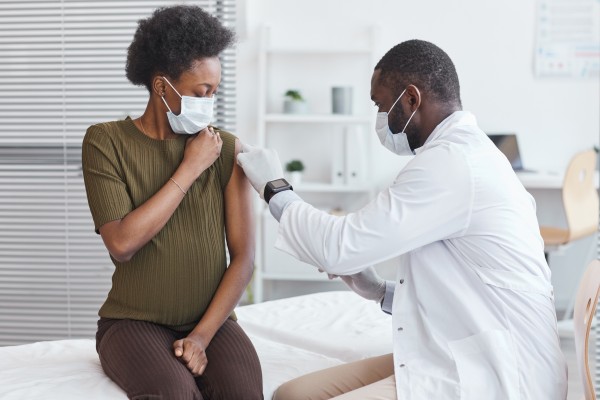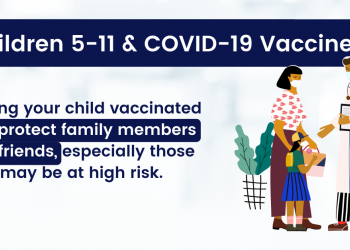This past July, The American College of Obstetricians and Gynecologists (ACOG) and the Society for Maternal-Fetal Medicine (SMFM) released a joint statement recommending that all pregnant individuals be vaccinated against COVID-19. In September, U.S. Centers for Disease Control and Prevention (CDC) issued an urgent health advisory to increase COVID-19 vaccination among pregnant and lactating people to prevent serious illness, deaths, and adverse pregnancy outcomes. The organizations’ recommendations in support of vaccination during pregnancy reflect evidence demonstrating the safe use of the COVID-19 vaccines during pregnancy. NACCHO supports the organizations’ push to urge pregnant individuals to be vaccinated against COVID-19.
Data have shown that COVID-19 infection puts pregnant people at increased risk of severe complications and even death. A recent study published by the CDC found that pregnant people infected with COVID-19 were at an increased risk of stillbirth in the U.S. compared to pregnant people without COVID-19, with a stronger association during the period of Delta variant predominance.1
Although stillbirth was a rare outcome overall, these findings highlight the importance of COVID-19 prevention strategies, including vaccination before or during pregnancy. Yet, according to the CDC, only about 35% of pregnant individuals have received one or more doses of the COVID-19 vaccine. In addition, significant disparities exist in vaccination coverage by race and ethnicity, with vaccination coverage being the lowest (21%) for non-Hispanic Black pregnant people.2
With support from the CDC’s Division of Reproductive Health, NACCHO recently collaborated with the What to Expect Project to survey pregnant people on their likelihood of receiving the COVID-19 vaccine (n= 1,141). These data show that most pregnant people and people who recently had a child sample were not vaccinated. Furthermore, regardless of race, urbanicity, income, and age, pregnant people exhibited hesitancy and concern around receiving the COVID-19 vaccine and its impact on themselves and their infants. This concern was most prominent among those who lived in rural areas or identified as non-white.
Only one in every three pregnant people surveyed received their vaccination during pregnancy (See A1). Respondents living in rural areas were less likely to be vaccinated than those living in suburban and urban areas. Additionally, while pregnant respondents were more than twice as likely to strongly disagree that the COVID-19 vaccine is the best method for protecting themselves and their babies, more non-white respondents were likely to report possible side effects to vaccination as a priority concern receiving the vaccine (See A2). When asked about their trusted sources for obtaining vaccination information for pregnant people, respondents indicated receiving information from experts, including doctors, federal agencies, and public health officials. On the contrary, unvaccinated people are more likely to receive information from people within their social circles and trusted community members, including friends or family and religious leaders, and social media (See A3).
Local health departments continue to play a pivotal role in addressing vaccination hesitancy among families in their communities. Given these findings, we strongly encourage local health officials to:
- Continue to enhance communication and messaging around the safety and efficacy of the COVID-19 vaccine for pregnant individuals.
- Promote vaccination to all people, especially pregnant people, in addition to the co-administration of the COVID-19 vaccine, influenza, and other vaccines, when appropriate.
- Use CDC’s COVID-19 Vaccines While Pregnant or Breastfeeding guidance and ACOG’s COVID-19 Pregnancy and Breastfeeding: A Message for Patients FAQs to help plan and promote the COVID-19 vaccine in your community.
- Continue to follow NACCHO resources to receive updates on federal guidance and messaging for promoting the vaccine.

Note: This graph displays vaccination status for those who were pregnant or postpartum in the sample. For those that received the vaccine, this graph shows when during their pregnancy they received the vaccine. In addition, we asked the sample if they had received at least one dose of the vaccine at the time of the survey.


The survey was administered from July 27- August 3, 2021. The majority of the sample were white (76%), obtained a college degree or higher (64%), full-time employees (61%) earning a household annual gross income of $75,000 or greater (55%), living in a suburban area (49%), and were between 26-35 years of age (60%). Pregnant people accounted for 56% of this population.
References
- DeSisto CL, Wallace B, Simeone RM, et al. Risk for Stillbirth Among Women With and Without COVID-19 at Delivery Hospitalization — United States, March 2020–September 2021. MMWR Morb Mortal Wkly Rep. ePub: 19 November 2021. DOI: http://dx.doi.org/10.15585/mmwr.mm7047e1external icon.
- COVID Data Tracker. Vaccinations Among Pregnant People. (accessed November 23, 2021)

